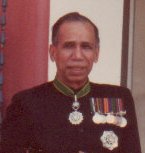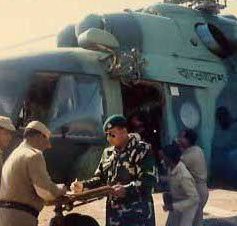
The Bangladesh Armed Forces are the military forces of the People's Republic of Bangladesh. They consist of the three uniformed military services: the Bangladesh Army, the Bangladesh Navy and the Bangladesh Air Force. The Armed Forces are under the jurisdiction of Ministry of Defence of the Government of Bangladesh, and are directly administered by the Armed Forces Division of the Prime Minister's Office. The President of Bangladesh serves as the Commander-in-Chief of the Bangladesh Armed Forces. Bangladesh has the third-largest defence budget in South Asia and according to the Global Firepower index, The Bangladeshi military is the 37th strongest in the world and the third most powerful military force in South Asia. Border Guard Bangladesh and Bangladesh Coast Guard are under the jurisdiction of the Ministry of Home Affairs during peacetime, but during wartime they fall under the command of Bangladesh Army and Bangladesh Navy respectively.

The Shanti Bahini was the armed wing of the Parbatya Chattagram Jana Samhati Samiti in Bangladesh. It is considered an insurgent group in Bangladesh. The Shanti Bahini was made out of mostly members from the Chakma tribe.

The Parbatya Chattagram Jana Samhati Samiti is a political party formed to represent the people and indigenous tribes of the Chittagong Hill Tracts in Bangladesh. Since its inception in 1972, the PCJSS has fought for autonomy and the recognition of the ethnic identity and rights of the indigenous tribes of the Hill Tracts. Its military arm, the Shanti Bahini was used to fight government forces and Bengali settlers in the Hill Tracts. A peace accord was signed in 1997 led to the disarmament of the Shanti Bahini and enabled the PCJSS to return to mainstream politics.

The Bangladesh Army is the land warfare branch and the largest component of the Bangladesh Armed Forces. The primary mission of the Army is to provide necessary forces and capabilities to deliver the Bangladeshi government's security and defence strategies and defending the nation's territorial integrity against external attack. Control of personnel and operations is administered by the Army Headquarters, Dhaka. The Bangladesh Army is also constitutionally obligated to assist the government and it's civilian agencies during times of domestic national emergency. This additional role is commonly referred to as "aid to civil administration".
Muhammed Abul ManzurBU was a Bangladeshi military officer who commanded the Bangladesh Forces operations in Sector 8 during the Bangladesh Liberation War against Pakistan in 1971. He was allegedly involved in the assassination of the then-president of Bangladesh, Ziaur Rahman. The erstwhile chief of army staff and alleged mastermind of Rahman's assassination, Hussain Muhammad Ershad, had put a standing shoot-to-kill order on Manzur's life—he was killed shortly after being captured at the border. About a year later, Ershad initiated a bloodless coup d'état and took over the central government, holding power until 1990.

1st East Bengal Regiment or 1st Bengal also known by its nickname The Senior Tigers of Bangladesh Army.

Bangladesh's military history is intertwined with the history of a larger region, including present-day India, Pakistan, Nepal, Bhutan and Myanmar. The country was historically part of Bengal – a major power in South Asia and Southeast Asia.

Manabendra Narayan Larma, also known as M.N. Larma, was a Jumma Chakma politician and member of parliament of Bangladesh. A leading proponent of the rights of the people of the Chittagong Hill Tracts, he was the founding leader of the Parbatya Chattagram Jana Samhati Samiti and its armed wing, the Shanti Bahini.

The Chittagong Hill Tracts Peace Accord was a peace agreement signed between the Government of Bangladesh and the Parbatya Chattagram Jana Sanghati Samiti, the political organisation that controlled the Shanti Bahini militia on 2 December 1997. The accord allowed for the recognition of the rights of the peoples and tribes of the Chittagong Hill Tracts region and ended the decades-long insurgency between the Shanti Bahini and government forces.
The Chittagong Hill Tracts Development Board was a government agency established in 1978 by the then-President of Bangladesh Ziaur Rahman in response to the rise of the Shanti Bahini insurgency in the Chittagong Hill Tracts of eastern Bangladesh. Currently Supradip Chakma, is the Chairman of this development board.

The Insurgency in the Chittagong Hill Tracts refers to a political and armed conflict that occurred in Bangladesh in two phases:

Quazi Golam Dastgir was a Bangladesh army general and diplomat. From 1975 to 1977, he served as the "Zonal Martial Law Administrator" for Dhaka Division.

Lieutenant Colonel Syed Mir Ali Imam Al Mamun is a retired Officer of Bangladesh Army and the head of the aristocratic Padamdi family of Rajbari, present day Bangladesh.
Alikadam Cantonment is a cantonment located outside of Bandarban. The 24th Infantry Division had jurdristriction over the cantonment under 69th Infantry Brigade. In 2015, the cantonment was shifted under jurdristriction of newly formed 10th Infantry Division headquartered at Ramu Cantonment with new 97th Infantry Brigade formed in here.
Bandarban Cantonment is a cantonment located in Bandarban. The headquarter of 69th Infantry Brigade of Bangladesh Army locate here. It is one of five cantonment in Chittagong Hill Tracts area.
Dighinala Cantonment is a cantonment in Dighinala, outside of Khagrachari. 24th Infantry Division of Bangladesh Army inhabit here.
Rangamati Cantonment is a cantonment located in Rangamati. 305th Infantry Brigade of Bangladesh Army inhabit here under 24th infantry division..
Khagrachhari Cantonment is a cantonment located in Khagrachhari, Bangladesh. 203rd Infantry Brigade of Bangladesh Army inhabit here. It is under the jurisdiction of 24th infantry division.
SM Kamrul Hassan is a two-star general of the Bangladesh Army. As Major General he is currently appointed as Senior Directing Staff at National Defence College, prior to that he was the Commandant of Bangladesh Military Academy (BMA) and also commanded the 66th Infantry Division and Rangpur Area, as General-Officer-Commanding (GOC). He was commissioned in the East Bengal Regiment with the 21st BMA Long Course as the top cadet in weapons training.
Mohammad Ziauddin, BU is a retired Bangladeshi military officer, who was the Commanding Officer of the 1st East Bengal Regiment during the Bangladesh Liberation War. He was awarded the Bir Uttom, the country's second highest gallantry award for his outstanding bravery in the Liberation War. His certificate number was 22.











